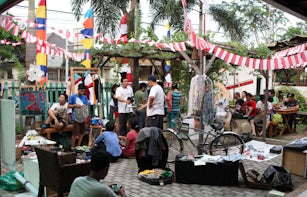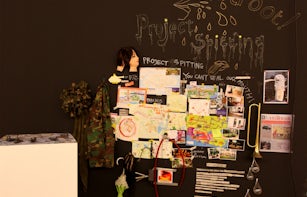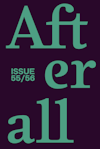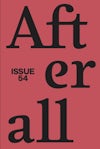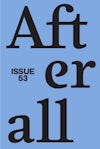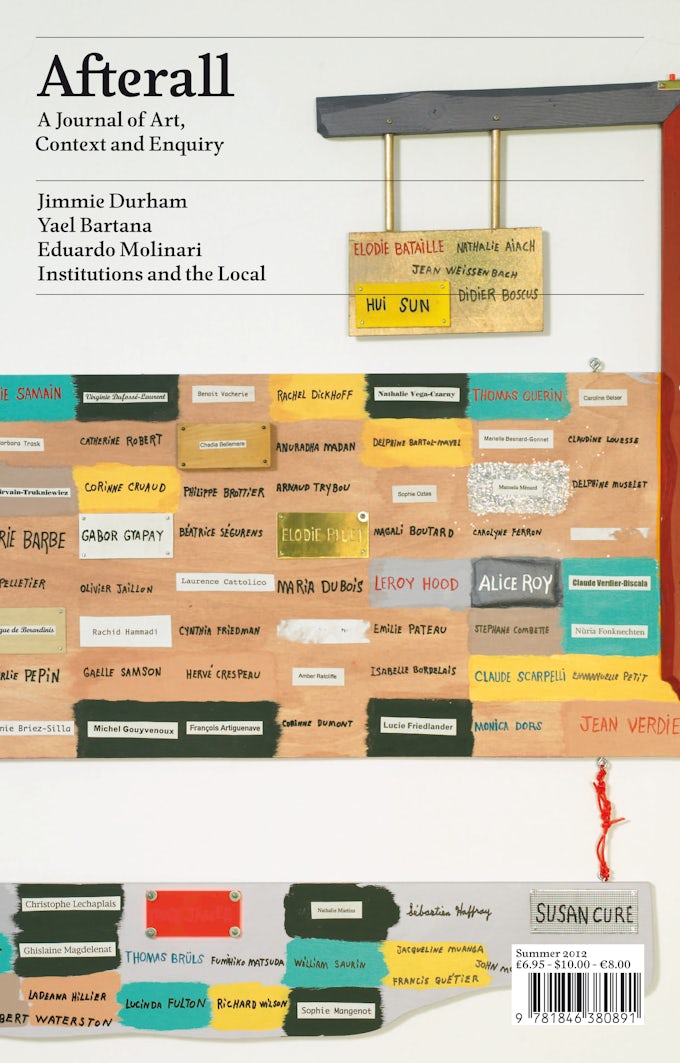
Issue 30
Summer 2012
Issue 30 looks at the relationship between institutions, artists and the local, with essays on Jimmie Durham, Theaster Gates, Yael Bartana and ruangrupa; organisations such as Grizedale Arts and the Artist’s Institute; and the history of artistic labour.
Editors: Nuria Enguita Mayo, Melissa Gronlund, Anders Kreuger, Pablo Lafuente, Stephanie Smith, Helena Vilalta.
Founding editors: Charles Esche, Mark Lewis.
Table of contents
Foreword
Contextual Essays
- Artistic Labour, Enclosure and the New Economy – Alberto López Cuenca
Artists
Jimmie Durham
- Stone as Stone: An Essay About Jimmie Durham – Anders Kreuger
- Jimmie Durham: For the Price of a Magazine – Anthony Huberman
Yael Bartana
- Loudspeaker and Flag: Yael Bartana, from Documentation to Conjuration – Volker Pantenburg
Eduardo Molinari
- A Conversation Between Eduardo Molinari and Nuria Enguita Mayo – Nuria Enguita Mayo
- Archivo Caminante: Constellations and Performativity – Teresa Riccardi
Theaster Gates
- Theaster Gates: Radical Reform with Everyday Tools – Hesse McGraw
Ruangrupa
- Who Cares a Lot? Ruangrupa as Curatorship – David Teh
- Ruangrupa: A Conversation on Horizontal Organisation – Nuraini Juliastuti
Events, Works, Exhibitions
- Envisaging Spatial Crisis: ‘On Capital and Territory’ and the Diagnosis of the Present – Mari Paz Balibrea
- Grizedale Arts: Use Value and the Little Society – John Byrne
Foreword
Can one curate a political movement — a grass-roots response to a set of political, economic and social circumstances — and exhibit it as artistic gesture? This is the question provoked by the 2012 Berlin Biennial, which Artur Żmijewski curated in collaboration with Joanna Warsza and Voina, and their invitation to Occupy Berlin and other Occupy movements to set up camp on the lower floor of Kunst-Werke, the main institution involved with the biennial. Judging by the reaction of its initial audiences over the first few weeks of the show, the presentation of Occupy appears neither an artistic work, even in the most fluid sense, nor an uncompromising political statement (the biennial is funded by public money) and for many simply clouds the already misty line between art and politics.
The collaboration between Kunst-Werke, an institution that has sidestepped much of the changes in programme and ways of working brought in by New Institutionalism in the 1990s, and the anarchic, internet-assisted movement of Occupy suggests that the question of community engagement, which has been so crucial for both artistic and institutional practice over the past forty years, is still shifting, and largely in tune with changes outside of the art world. The terms of New Institutionalism varied theoretically and practically, but took as a starting point that the programme of an institution after Institutional Critique needed dialogical engagement with a community (which, though again variously defined, was taken as a de-individualised group of people). 1 The meeting of Żmijewski, Kunst-Werke and Occupy implies, instead, a privileging of individual voices: the towering figure of Żmijewski, whose artistic reputation was understood by the selection committee to translate into curatorial nous; the programme of Kunst- Werke, which has tilted towards traditional exhibition forms; and the Occupy movement, whose radically democratic meeting style — where in many cases no decision will go through unless all members agree — means it is often unable to form consensus on its main goals. Rather than presenting Occupy as a logical extreme of a dispersed, socially and politically engaged practice, Kunst-Werke’s hosting of Occupy seems, so far, to stymie participation — should one join? Critique? Walk by? The undetermined means of participation is surprising, not only because ‘engagement with the local’ has become core to biennial programming, but also because the Berlin Biennial, based in an artist-heavy city, has so successfully addressed the subject in the past, both in the 2002 biennial that drew on the history of the city, and in the subsequent biennial, which had a long-term event programme especially conceived for local residents. However, the biennial’s difficulty in articulating its political relation to its public should translate not into crowing about failure but rather suggest a continuing need to look at New Internationalism and its different legacies.
Indeed with this issue of Afterall we are seeking to look in detail at how different types of institutions, from artists’ initiatives to curatorial and research organisations, might engage with the ‘local’ and ‘social’ — using test cases to determine the extent to which institutions have allowed local engagement to affect their programming ethos and methodology. How has the discourse of the participatory changed the curatorial landscape? How are artists taking on board today the relationship to the ‘local’ that those ‘new institutions’ brought to the fore? How has the discourse of the participatory changed the curatorial landscape? And finally, how does the current discussion around forms of artistic labour and the valuation of artistic production change the way we think about the artwork made by the artist in association with the institution?
Purchase
The publication is available for purchase. If you would like specific articles only, it is also available individually and to be downloaded as PDFs.
Purchase full publication
Buy via University of Chicago Press
Buy via Central Books
Purchase individual articles
Buy via University of Chicago Press
